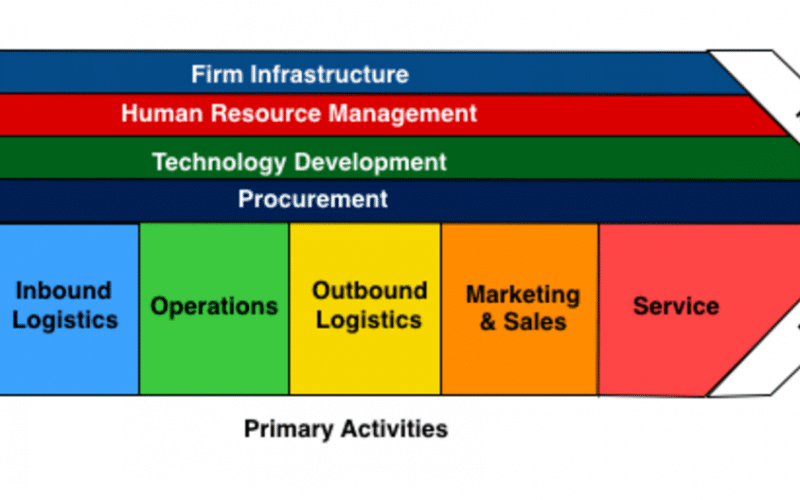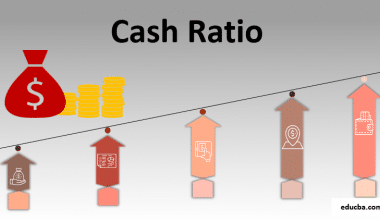What is your company’s competitive advantage? A value proposition assists businesses in determining what differentiates them from competitors. But how can you tell if your business activities are providing the most value to your customers while also generating a high-profit margin?
A value chain is used to describe all of the business activities required to create a product from beginning to end (e.g., design, production, distribution, and so on). A value chain analysis provides businesses with a visual representation of these activities, allowing them to identify areas where they can cut costs.
Using the results of this analysis, you can take steps to gain a competitive advantage, improve efficiency, and boost profit margins. Let’s take a closer look at a value chain analysis example and see how you can use it to analyze your business activities.
What is Value Chain Analysis?
A value chain analysis is a method for firms to examine the actions that go into making a product. Once the actions have been examined, a company can utilize the information to determine how to increase its competitive edge.
While improving operational efficiency is one of the purposes of value chain analysis, the ultimate and most essential goal is to develop a competitive advantage.
As you complete your value chain analysis, you will determine the competitive advantage you are attempting to obtain. Companies can select between two types of competitive advantage: cost advantage and differentiation advantage. Let’s go over these in more detail below.
The Competitive Advantage
Your company’s competitive advantage is what distinguishes it from competitors. To get an advantage, you must first identify your target market. If you’re an entrepreneur looking to precisely define your company’s target audience and market, identify the right niche market for launching or selling your items.
You’ll also need a strong understanding of your competitors and their offers, as well as the benefit your product gives to the target market.
A company’s goal in developing a value chain analysis is to achieve a competitive advantage in one of two areas.
Cost Advantage
A cost advantage approach seeks to make you the lowest-cost provider in your sector or market. Companies that thrive at a low-cost strategy have extremely efficient operations and use low-cost materials and resources to minimize the overall price of their product or service. McDonald’s and Walmart are two examples.
Differentiation Advantage
To achieve a competitive edge, you use a differentiation strategy to offer a unique or highly specialized product or service. The organization must devote time and resources to innovation, research, and development. An effective differentiation strategy enables a company to charge a premium for its product or service. Starbucks and Apple are two examples.
It is advisable to concentrate your efforts on a single competitive advantage. The purpose of your value chain analysis will be to either lower costs or distinguish to boost margins, depending on the competitive strategy you adopt. Then you’ll have a clear understanding of your company’s aims and how you intend to give value. It also limits the breadth of improvements that may be required to improve efficiency.
But how do you decide which competitive advantage to pursue? Using Porter’s value chain model, you may examine your business activities, identify a distinct value proposition, and determine your best option for gaining a competitive advantage.
Value Chain Analysis by Porter
In his book “Competitive Advantage,” Harvard Business School professor Michael Porter presented a simple value chain model. He devised the procedures for conducting a value chain analysis and classified corporate activities into two categories: primary and secondary.
Identifying the basic and secondary operations is an important stage in developing a value chain analysis. You’ll know where you spend the most money, where your company can improve, and where your competitors can outperform you.
Let’s have a look at these activities in more detail below.
Primary and Support Activities
Primary and support activities are the key processes and systems that a company employs to develop its product or service, according to Porter’s value chain model. Inbound logistics, operations, outbound logistics, and sales are the five key activities. Firm infrastructure, human resource management, technological development, and procurement are examples of support activities of value chain analysis.
Primary Activities of the Value Chain Analysis
Five key activities encompass all of the actions that contribute to the establishment of a business’ offering.
#1. Inbound Logistics:
This is the process of acquiring materials and resources from suppliers before the development of the end product or service. Consider the locations of your suppliers as well as the shipping costs from their facility to yours in your study.
#2. Operations
Operations are the processes by which materials and resources are created, resulting in a finished product or service. You may examine the costs of running your warehouse, machinery, and assembly lines here.
#3. Outbound Logistics:
Once a product or service has been completed, it must be distributed. This delivery process is referred to as outbound logistics. Consider your consumer shipping expenses, warehousing fees, distributor relationships (do they charge a fee for each sale, for example?), and order processing procedures.
#4. Marketing and Sales
Marketing and sales are the methods used to show and sell your product or service to your ideal target market. Consider advertising expenditures, promotional costs, reach, and cost-per-acquisition in your analysis.
#5. Services:
This is the assistance that a company provides to its customers, which might include product support and training, warranties, and guarantees. You will examine maintenance expenses, product training costs, product adjustment frequency, and other factors.
Support Activities of the Value Chain Analysis
Support activities assist primary activities in gaining a competitive edge. They are as follows:
#1. Firm Infrastructure:
This refers to all of the management, financial, and legal processes that a company has in place to make business decisions and manage resources effectively.
#2. Human Resource Management (HRM):
HRM comprises all of the activities and systems involved in managing employees and employing new personnel. This is especially critical for businesses that provide in-person service, as having good personnel can provide you a competitive advantage.
#3. Technology Development:
Technology development aids a company’s ability to innovate. Furthermore, technology can be employed at many stages of the value chain to achieve a competitive edge by enhancing efficiency or cutting production costs.
#4. Procurement:
Procurement is the process of obtaining resources and supplies for a product as well as locating suppliers. The goal is to discover high-quality materials that are within the company’s budget.
It is now time to put everything together in a single effort. We’ll go over the most frequent value chain analysis steps below.
Steps in Value Chain Analysis
- Determine the major and secondary activities of the company.
- Examine the worth and expense of the activities.
- Recognize chances for gaining a competitive advantage.
Value chain analysis necessitates study and might be time-consuming to construct. The general steps for creating a value chain analysis are outlined below.
#1. Determine the major and secondary operations of the company.
The value chain is made up of primary and secondary activities. They include every step in the process of creating a product or service, from raw material to finished product.
#2. Determine the worth and expense of the actions.
The team in charge of developing the value chain analysis should consider how each action adds value to customers and the business as a whole. Compare the activity to the competitive advantage you want to attain (cost leadership or difference) and determine if it helps you get there.
After you’ve completed the value analysis, look at the costs of the activities. Is the activity time-consuming? What is the price of X raw material? Similar inquiries will aid in determining which activities are cost-effective and which are not. This is where you may identify areas for improvement.
#3. Look for ways to obtain a competitive advantage.
Once the value chain analysis is completed, the major stakeholders in the business will have a clear picture of where the company excels and where operational improvements may be made.
Begin with tiny modifications that result in high-impact consequences. After identifying and implementing the easy wins, you and your team can move on to the more difficult obstacles that may be impeding efficiency.
The value chain analysis provides businesses with a clear picture of how to adapt their actions and processes to provide the most value to their target market while increasing profit margins.
Still, confused about how it all works? Consider the following value chain analysis example.
Example of a Value Chain Analysis
Completing a value chain analysis enables companies to assess their operations and identify competitive opportunities. McDonald’s aim, for example, is to supply customers with low-cost meal options. The value chain analysis example assists McDonald’s in identifying areas for improvement as well as initiatives that add value to its products and services.
An example of a value chain analysis for McDonald’s and its cost leadership plan is shown below.
#1. Primary Activities of the Value Chain Analysis
- Inbound Logistics: McDonald’s has pre-selected low-cost suppliers for its food and beverage items. It seeks out suppliers for commodities such as vegetables, pork, and coffee.
- Operations: The company is a franchise, and each McDonald’s establishment is owned by a franchisee. McDonald’s has over 39,000 outlets worldwide.
- Outbound Logistics: Rather than formal, sit-down restaurants, McDonald’s features counter-service, self-service, and drive-through locations.
- Marketing and Sales: Its marketing methods are centered on media and print advertising, which includes social media posts, magazine adverts, billboards, and other forms of advertising.
- Services: McDonald’s tries to provide excellent customer service. It gives extensive training and benefits to its thousands of employees so that they can better serve their consumers.
#2. Support Activities of the Value Chain Analysis
- Firm Infrastructure: The McDonald’s organization features C-suite executives as well as Zone Presidents who supervise the firm’s operations in various locations, as well as a general counsel who oversees legal matters.
- Human Resource Management: It has a career website where job seekers can apply for positions in both corporate and restaurant settings. To attract talent, it pays hourly and salaried rates and promotes its tuition help program.
- Technology Advancement: To expedite ordering and increase operational efficiency, the restaurant has invested in touch kiosks.
- Procurement: The company employs Jaggaer, a digital procurement service, to build partnerships with important suppliers from around the world.
Summary
Your value chain analysis will assist you in identifying areas for improvement as well as the activities that add the greatest value to your consumers and your organization as a whole. Eliminating wasteful business activities improves your competitive edge and raises your profit margins.







